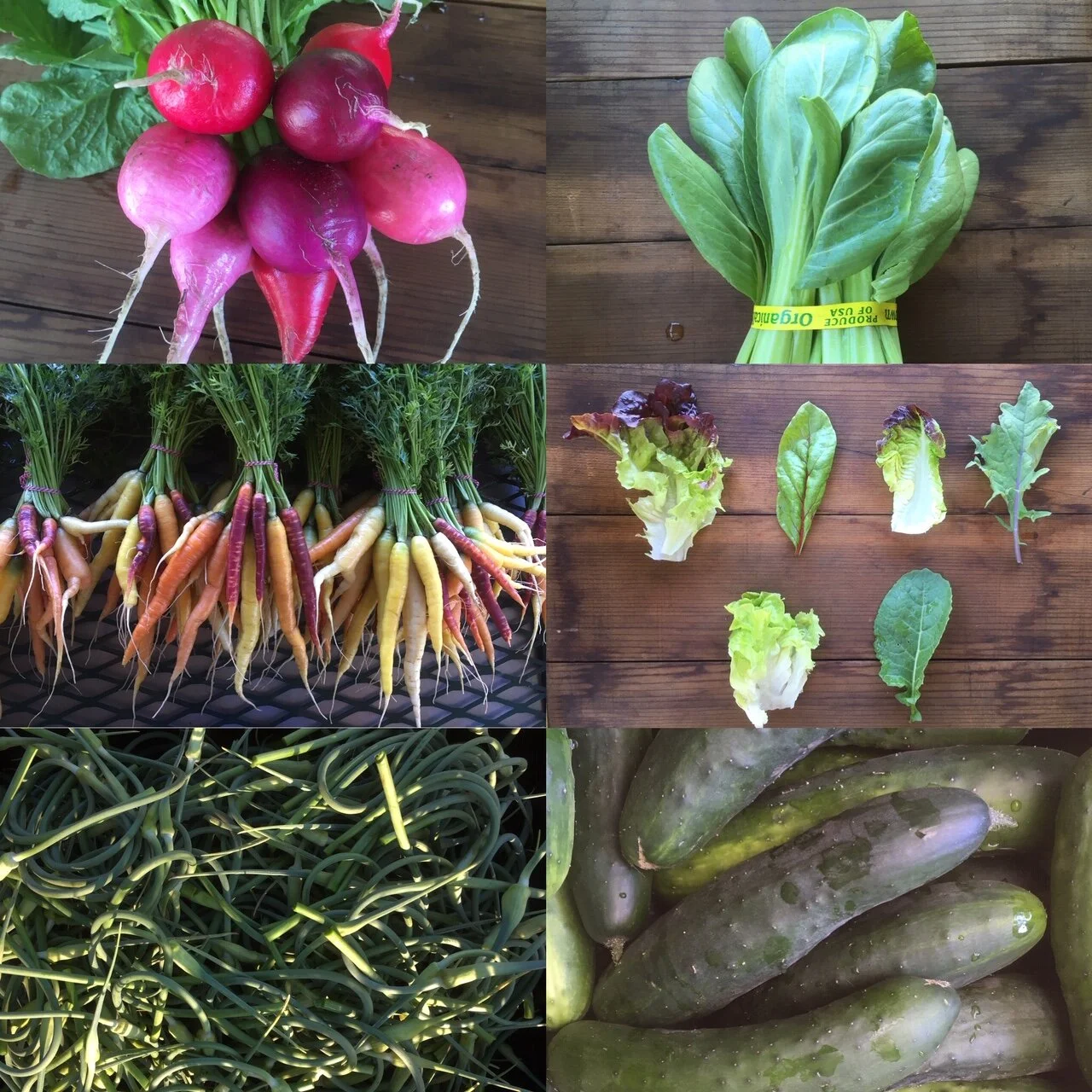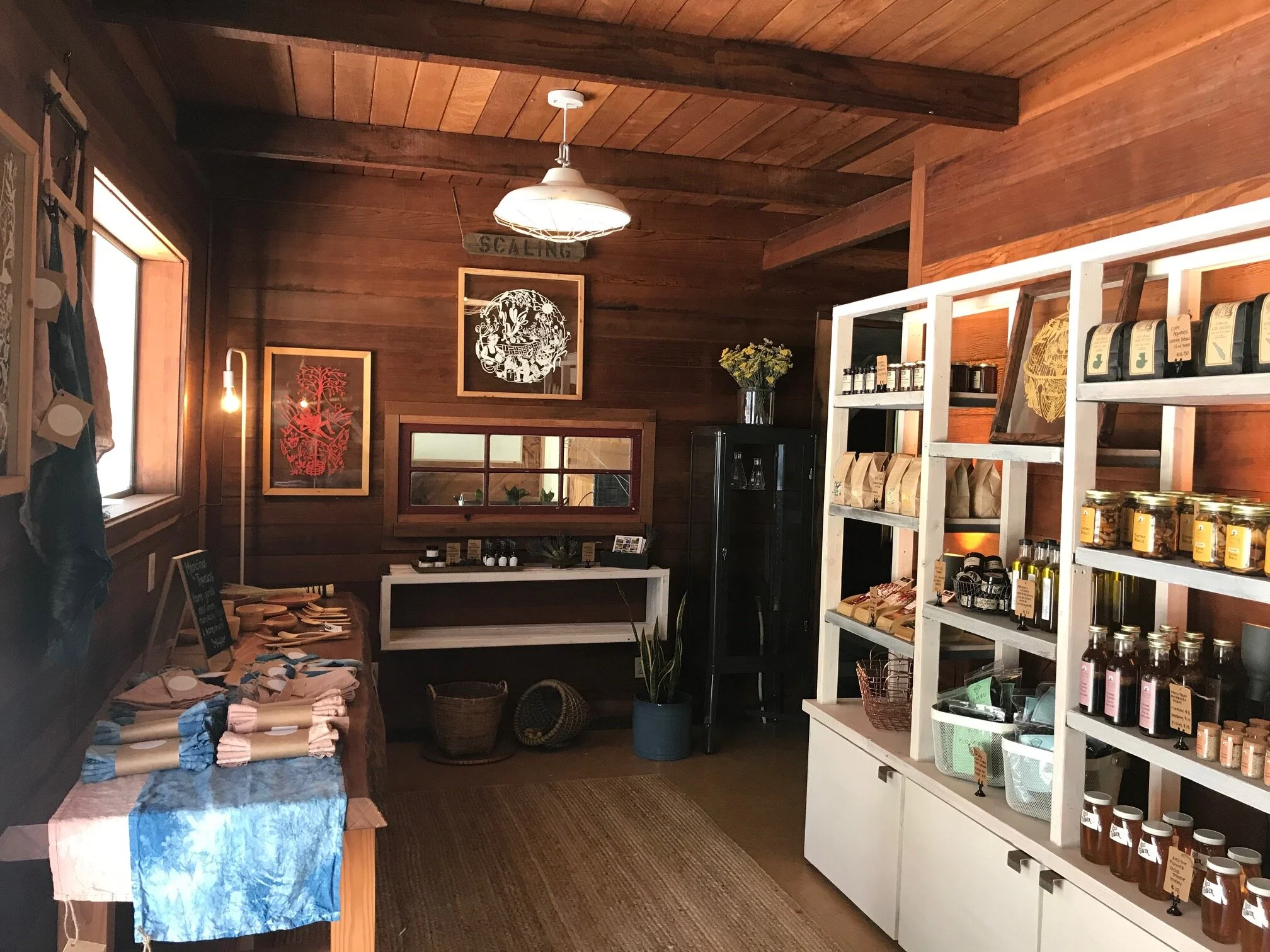THIS WEEK’S HARVEST
Bunched Rainbow Carrots, Fresh Cipollini Onions, Easter Egg Radishes, Dino Kale, Rainbow Chard, Mei Qing Bok Choi, Summer Squash, Olympian Cucumbers, Arugula, Tasty Town Salad Mix, Spinach, Cegolaine Little Gems, Iceberg Lettuce, Garlic Scapes
U-PICK
Albion Strawberries
Sugar Snap Peas
Frying Peppers (see below for harvest tips)
Herbs: Rosemary, Thyme, Dill, Italian Basil, Thai Basil, Purple Basil, Oregano, Marjoram, Parsley, Tarragon, Onion Chives, Garlic Chives, Vietnamese Coriander, Culinary Lavender, Culinary Sage, French Sorrel, Lemon Verbena, Lemon Balm, Shiso (limited), Chamomile, Cilantro, Tulsi, Mints!
Flowers galore!
Frying peppers are here! Shishitos at left and in the pint basket, and a Padrón at right.
HARVEST NOTES
Tasty Town Salad Mix: All aboard the Tasty Train to Tasty Town! This week’s ready-to-eat salad mix is a totally tasty mix of baby Chard, baby Red Russian Kale, three different type of lettuce, and Amara Ethiopian Kale. Ethiopian Kale is an exceptionally tasty relative of Mustard Greens that tastes like it’s been infused with rich garlic. Choo-choo!
Frying Peppers: So it begins: The summer gift that keeps on giving — frying peppers. Frying peppers are little peppers commonly cooked. A little olive oil, a little salt, a little pan sear, and wallah, an incredible hors d'oeuvre!
Shishitos: A wonderfully mild (no heat), green frying pepper. Popular in Japan where its thin walls make it particularly suitable for tempura. Also very good in stir fries or sautés, or just seared in oil and salt. Ideally harvest at 2 to 4 inches, but bigger is fine. Older peppers turn red but are 99% mild.
Padróns: The famous Spanish heirloom, named after their town of origin. Padróns are served sautéed in olive oil with a little sea salt, and eaten as tapas in Spain. Ideally harvest when they are 1" to 1 1/2" long. About 1 out of 10 fruits will be hot. All the fruits become hot if allowed to grow 2-3" long.
Fresh Cipollini Onions: A sweet, freshly harvested delicate onion that is so mild you can cut it thin and eat in on pizza, salad, or straight up! Or trying grilling them until translucent and slightly charred.
THE MARKETPLACE
As you all have certainly discovered by now, our humble little Mill site is now home to the sweetest Marketplace in town. Our friend and neighbor Kim LaVere and everyone at Green Valley Farm + Mill did such a good job transforming a room of the Mill office building into the most incredible ode to our local foodshed, stocking it with art, soaps, mushroom concoctions, beverages, and other pantry items. If you haven’t checked it out already, do yourself a favor! Well done all!
TIPS FOR HARVESTING FLOWERS
If possible, harvest when it’s cooler out.
Get the stems in water immediately
Strip leaves that are going to be under water (avoids rotting, bad smells, and disease)
Cut low on the plant while ensuring there are lot of healthy leaves below where you are harvesting.
Ideally cut above a branching point to encourage new growth
Deadhead! If you have the time, clip off any dead / spent blooms on the plant to encourage more flowers next week!
FARMER’S LOG
ON THE Flower Garden
As the flowers in the garden really start to flourish, we thought we’d lift the curtain a little on our beloved blooming hillside.
While we are primarily a food farm we often feel like the symbolic heart of what we do is in the flower garden — little laughing gifts from us to you, from the land to you — the sole purpose of which is to enchant and uplift the soul.
Kayta is the mother of the flower garden. She researches, trials and chooses what we plant; designs the plantings and successions; propagates the flowers and cares for their sometimes complicated needs. In the evenings, you can usually find her up in the flowers at Golden Hour, trying to get close to Meeko the shy garden cat, or saying goodnight to a sleeping bumble bee. It is a pet project of hers, a source of joy and a living art installation whose mission is to provide cut flowers en masse while being relatively low maintenance (while we focus on the food farming) and giving back to the ecology around us.
We’ve learned some things and met some amazing flower friends along the way…
INCEPTION
The original idea for coupling a u-pick cut flower garden with a CSA pick-up comes from Caretaker Farm in Williamstown, MA, where Kayta and I apprenticed in 2012. It seemed to us a natural match, taking home a beautiful little bouquet with a bag full of produce. The flower and herb garden at Caretaker was just outside the door of their big old barn and overlooked the beautiful cultivated valley below. If we had time at the end of the day us apprentices were sent to weed the flowers. It was a modest flower garden: a few zinnias, gomphrena, celosia and other tidbits.
We moved to Sebastopol in 2013, and in 2014 Kayta started a small farm at Russian River Vineyards in Forestville. There, Kayta began experimenting with flowers, inspired by the horticultural bounty, the natural environment, and the incredible Slow Flower movement of Sonoma County (spearheaded by people like Hedda Brostrom of Fullbloom Flower Farm in Graton and Auna Fisher of Beija Flora Botanicals).
When we started GVCFarm in 2016, a friend gifted us with 50 lbs of dahlia tubers from her garden. Whether or not those tubers were devoured by gophers is beside the point — the idea of an epic u-pick flower garden was planted.
THE WORKHORSES AND THE UNICORNS
One way we conceptualize our flower garden crop plan to ourselves is by dividing it into the “workhorses” and the “unicorns”.
The “workhorses” are flowers that have proven themselves: Beautiful, hearty and reliable, super productive. Zinnias and Cosmos. We plant those twice each year so that if a meteor hit Sonoma County, we could all still make bouquets. We are always on the lookout for workhorses. Last year, Strawflower was a workhorse for us and we hope this year is the same. Snapdragons, while shorter blooming than others, are usually a sure bet. Rudbeckia, which has perennialized itself in the upper-most West bed, is worth more than its salt. Celosia, Gomphrena, and Marigolds come to mind. It seems as though Lavatera, the crazy loaded pink and white flower blooming just above the garden strawberries seems like it might be the new-to-us workhorse of 2020.
The unicorns are our little pets — delicate, special, rare, experiments, trials, and hunches. Kayta has us plant these for a number of reasons. Reason #1: Just ‘cuz. Reason #2: As a gift to the pollinators (like the Phacelia aka Bee’s Friend, rather quick to peter out, was a vision of beauty at its peak in early June humming with countless pollinators) Reason #3: They are so unique and shapely and we can’t not plant them and they make bouquets pop (hello, ornamental Amaranth!) Reason #4: Experiments to find the next workhorses or the next natives & cultivated natives.
In this way the flower garden is a living game of trial and error, the results of which we can take home to decorate with!
Some members of the Unicorn / Native Category L to R, Top to Bottom: Blue Penstemon (with Lavatera behind it), Hollyhock, cultivated California poppy, Nicotiana, Amaranth and Dahlia, Veronica (or Speedwell).
ADAPTING TO PLACE
A long term goal of the flower garden is to find more and more natives or cultivated native varieties to use and to transition more beds into perennial zones.
This year we are experimenting with a cultivated California poppy variety (just below the ornamental Amaranth) and a cultivated Verbascum, a domesticated version of the wild Verbascum, the Dr. Suesse-esque, long-spired, yellow-flowered tower blooming everywhere around the farm.
We also have a very special Blue Springs Penstemon blooming secretly on the upper-most bed above the garden strawberries. You’ll find it tucked in between the masses of blooming Nicotiana.
The upper-most beds (2 on the West side and one long one on the East side) are all experiments in perennials. These are great because they are low maintenance for us, provide more year around blooms for pollinators, and year ‘round habitat for other insects.
THE SLEEPING BUMBLEBEES
But really, we do it all for the sleepy bumblebees.
If you don’t already know, the best time in the garden is sunrise or the Golden Hour of late evening. These are the liminal times — the magic times.
The low light highlights the color of the flowers and they shine as if glowing from within. The plants themselves breathe easy — soaking up the first light of day, or sighing from relief from the mid-day sun. All the pollinators are out, eating their first, or their last meals of the day. Even Hummingbird Moth aka Shrimp Bee is there!
And in the evening, when the light is almost extinguished, if you tread softly, you will see them — Bumble Bees falling asleep on the Nicotiana or tucked into a Cosmo — snoring imperceptible snores. And out of the corner of your eye the red and blue flash of Nuthenroy the Gnome scurrying into the hedges…
See you in the flower garden,
David for Kayta, Anna & Kate






